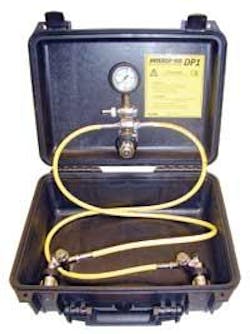Compact Divator apparatus is lighter and easier to operate
Interspiro, a specialist in respiratory protection for diving, fire-fighting, and general work in hazardous environments, has introduced a new range of scuba diving products of interest to the offshore sector. The Sweden-based company, owned by Ocenco Inc., also counts armed forces, coastguards, police forces, and firefighting bodies among its leading customers.
The Divator Mark II 324 diving apparatus has proved very popular for SAR (search and rescue) purposes, according to Niclas Gyllbrink, vice president, marketing. This is a compact system suitable for use in confined spaces, which features two 300-bar, 4-liter cylinders.
Freedom of movement
In contrast with competing products, the regulator valve in this model is located at the bottom of the cylinders so that the diver can work unimpeded by hoses about the upper body. The equipment is of robust construction, and the components have been designed for ease of location to facilitate working in the dark. Although developed for use in a cold climate, it is also suitable for warmer waters.
Due to the design of the large capacity regulator, breathing resistance is very low even when the cylinder pressure itself is low. The equipment incorporates a full face mask, which has several interesting features:
* Ingress of contaminated water is prevented by a constant, slight over-pressure
* The inside of the visor is flushed with dry air to keep it free of contamination
* The airways are designed to minimize ‘dead space’ volume, thereby preventing build-up of carbon dioxide
* The breathing valve has a non-return valve, which minimizes the risk of ice forming in the inlet port
* A purge button makes it possible to drain any free water out of the valve.
Surface air supply
Also of interest to the offshore sector is the Divator DP1 system for surface supply diving. This product, used among others by the Swedish Coastguard, incorporates a high-pressure hose through which air is delivered from the surface at 300 bar. The regulator is incorporated in the diver’s equipment. Pressure settings are automatically adjusted for different depths. If the pressure falls below a set level, an acoustic alarm automatically sounds.
The design of the Divator DP1 incorporates significant improvements on traditional surface supply diving equipment, Gyllbrink says. Conventional apparatus is based on a low-pressure system in which the air pressure is reduced in stages - down to 6-7 bar at a first-stage regulator, and then down to below one bar at the breathing valve. This arrangement means that the diving operator at the surface must keep monitoring the pressure and adjusting it in accordance with the diver’s depth. The Divator DP1 system, in contrast, allows the operator to concentrate fully on the diving mission.
Another benefit of Divator DP1 is the very thin hose, which has a diameter of only 10 mm. It weighs about 10% of the hose typically used by low-pressure systems - a 60 m Divator DP1 hose weighs only 5.3 kg. It compares well in other respects, too. While the low-pressure system hose is normally heavy and bulky and liable to be pulled by currents, the high-pressure hose is easy for the diver to handle and less subject to currents.
The high-pressure hose, which also functions as a safety rope, is available in lengths of up to 120 m. As the depth limit for scuba diving is 55 m, the longer hose gives the diver plenty of freedom of lateral movement. Features such as radio communication and depth measurement can also be combined in the hose.
The system is also well suited for long duration dives. There are connections to two air banks, with a shuttle valve that makes it easy to switch from one to the other. It can also be combined with a cylinder system, with automatic switching if the air supply from the surface is interrupted for any reason.
The system is fully mobile - the surface supply box weighs 4.9 kg and measures 420 x 400 x 200 mm - and allows rapid deployment in remote locations. It can be combined with a standard Divator Mark II for use as a bailout apparatus. Divator DP1 complies with the EN 139 and EN 250 standards.
Composite cylinders
Last year, the company introduced composite cylinders for diving - Divatorlite. These are less than half the weight of steel cylinders - a 3.4-liter cylinder weighs 2.45 kg in air and a 6.7-liter cylinder 4.7 kg - so they considerably facilitate movement for the diver. The company was the first to introduce composite cylinders for use in air back in 1991 in a joint development with ABB.
In fact Interspiro is responsible for a series of developments, many of which have since become standard in the sector. Among its achievements are the invention of positive pressure in 1971, the first self-testing computerized breathing apparatus in 1996, and the first CBRN approval for a self-contained breathing apparatus (SCBA) in the aftermath of 9/11.
For more information, contact Niclas Gyllbrink, Interspiro. Tel +46 86365100, fax +46 8765 4853, [email protected], www.interspiro.com.

